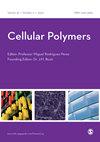丙烯腈-丁二烯-苯乙烯三元共聚物对聚丙烯发泡行为的影响
IF 1.9
4区 医学
Q4 MATERIALS SCIENCE, BIOMATERIALS
引用次数: 15
摘要
为了改善普通聚丙烯(PP)的泡沫结构,采用丙烯腈-丁二烯-苯乙烯三元共聚物(ABS)和增容剂与PP共混,研究了PP/ABS共混物的发泡性能。采用熔融挤出法制备了不同组分的PP/ABS共混物的固体和泡沫样品,然后采用常规注塑成型,加入或不加入发泡剂。采用拉伸试验、动态力学分析仪、差示扫描量热法、扫描电子显微镜、x射线衍射和扭矩流变法研究了这些样品的力学性能、热特征和流变学特征。结果表明,ABS是提高PP发泡性能的合适候选材料。ABS和增容剂对PP发泡性能的影响可归因于三种可能的机制,即有利于细胞成核的相间弱相互作用,防止气体逸出的气熔粘度的提高,以及有助于形成精细发泡结构的结晶行为的影响。本文章由计算机程序翻译,如有差异,请以英文原文为准。
Effect of acrylonitrile–butadiene–styrene terpolymer on the foaming behavior of polypropylene
To improve the cellular foam structure of common polypropylene (PP), acrylonitrile–butadiene–styrene terpolymer (ABS) and compatibilizer were used to blend with PP, and the foaming behavior of PP/ABS blends was investigated. The solid and foamed samples of the PP/ABS blend with different component were first fabricated by melt extrusion followed by conventional injection molding with or without a blowing agent. The mechanical properties, thermal features, and rheological characterizations of these samples were studied using the tensile test, dynamic mechanical analyzer, differential scanning calorimetry, scanning electron microscopy, X-ray diffraction, and torque rheometry. The results suggest that ABS is a suitable candidate to improve the foamability of PP. The effect of ABS and compatibilizer on the foamability of PP can be attributed to three possible mechanisms, that is, the weak interaction between phases that facilitates cell nucleation, the improved gas-melt viscosity that prevents the escape of gas, and the influence of crystallization behavior that helps to form a fine foaming structure.
求助全文
通过发布文献求助,成功后即可免费获取论文全文。
去求助
来源期刊

Cellular Polymers
工程技术-材料科学:生物材料
CiteScore
3.10
自引率
0.00%
发文量
9
审稿时长
3 months
期刊介绍:
Cellular Polymers is concerned primarily with the science of foamed materials, the technology and state of the art for processing and fabricating, the engineering techniques and principles of the machines used to produce them economically, and their applications in varied and wide ranging uses where they are making an increasingly valuable contribution.
Potential problems for the industry are also covered, including fire performance of materials, CFC-replacement technology, recycling and environmental legislation. Reviews of technical and commercial advances in the manufacturing and application technologies are also included.
Cellular Polymers covers these and other related topics and also pays particular attention to the ways in which the science and technology of cellular polymers is being developed throughout the world.
 求助内容:
求助内容: 应助结果提醒方式:
应助结果提醒方式:


